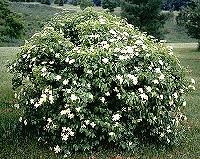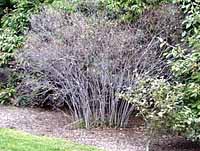Viburnum leaf
beetle home
Guide to identifying viburnums
Susceptibility to infestation - Which viburnum species are most likely to be attacked, and which are relatively resistant.
Timeline - How to spot damage through the year.
Common names
Scientific names
Logo images by Kent Loeffler, Paul Weston & Craig Cramer
|

|
Arrowwood viburnum (Viburnum dentatum), a native of eastern North America. Larger view.
|
You may not think you know what a viburnum is. But chances are good that you've seen one of these shrubs or small trees before, or that one is growing nearby.
Perhaps you are more familiar with the common names of some of the species, such as cranberrybush, hobblebush, arrowwood, nannyberry, or snowball bush. (More common names.)
Some are native species that you'll commonly find in the woods or old fields. Others are imported ornamental plants more often grown in landscaped areas.
Viburnums are a large and varied group woody plants. Most are deciduous (lose their leaves in fall), though some are evergreen. They range in size from 2 to 20 feet tall, and are often grown for screening or in hedges. Many are popular because of their fragrant, showy flowers, attractive fall foliage or colorful fruits, which provide season-long interest and food for birds and other wildlife.
While there are many different species, they have a lot in common. Their leaves take on many shapes, from lance-shaped to rounded, lobed (like a maple) or toothed. But they are all arranged in pairs opposite each other on the twigs. (The branches are arranged the same way.)
Most all viburnums bear clusters of white flowers (sometimes pink) on the ends of their branches in spring, which yield clusters of red, blue or blue-black fruit in fall.

|
Viburnums can die after two or three years of defoliation by viburnum leaf beetles. Larger view.
Photo by Paul Weston |
Unfortunately, many species of this plant also attract viburnum leaf beetles, which eat only the leaves of susceptible viburnum species during both the larval and adult stages of their lifecycle. The viburnum leaf beetles can completely defoliate plants, causing dieback or eventually death. Viburnums that are defoliated for two to three years more than likely will die.
Nevertheless, researchers are finding that not all viburnum species are susceptible to the viburnum leaf beetle. In fact, some species are not touched by the beetle at all. (See list of susceptible and resistant viburnums.)
We are just beginning to learn about the relationship between the beetle and the different species of viburnums and why some species are more susceptible than others. You can help us learn more by telling us the species of viburnums from which you gather data. We're interested in knowing both those that are infested and those that are not.
To learn how to identify viburnum species, see Guide to identifying viburnums. We've limited our key to those viburnums you are most likely to encounter in the Northeast in general and New York in particular.
© Copyright, Department of Horticulture, Cornell University.
Project coordinator: Lori Brewer, ljb7@cornell.edu
Website design: Craig Cramer cdc25@cornell.edu
Mention of trade names and commercial products is for educational purposes; no discrimination is intended and no endorsement by Cornell Cooperative Extension or Cornell University is implied. Pesticide recommendations are for informational purposes only and manufacturers' recommendations change. Read the manufacturers' instructions carefully before use. Cornell Cooperative Extension and Cornell University assumes no responsibility for the use of any pesticide or chemicals. Some of the links provided are not maintained by Cornell Cooperative Extension and Cornell University. Cornell Cooperative Extension and Cornell University are not responsible for information on these websites. They are included for information purposes only and no endorsement by Cornell Cooperative Extension or Cornell University is implied. Cornell Cooperative Extension provides equal program and employment opportunities.
|